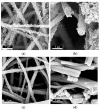Design of a Highly Sensitive Reduced Graphene Oxide/Graphene Oxide@Cellulose Acetate/Thermoplastic Polyurethane Flexible Sensor
- PMID: 35590970
- PMCID: PMC9099808
- DOI: 10.3390/s22093281
Design of a Highly Sensitive Reduced Graphene Oxide/Graphene Oxide@Cellulose Acetate/Thermoplastic Polyurethane Flexible Sensor
Abstract
As a substitute for rigid sensors, flexible sensing materials have been greatly developed in recent years, but maintaining the stability of conductive fillers and the stability of micro-strain sensing is still a major challenge. In this experiment, we innovatively prepared a polyurethane-based cellulose acetate composite membrane (CA/TPU) with abundant mesopores through electrospinning. Then, we reduced graphene oxide (rGO)-as a conductive filler-and graphene oxide (GO)-as an insulating layer-which were successively and firmly anchored on the CA/TPU nanofiber membrane with the ultrasonic impregnation method, to obtain an rGO/GO@CA/TPU sensor with a GF of 3.006 under a very small strain of 0.5%. The flexibility of the film and its high sensitivity under extremely low strains enables the detection of subtle human motions (such as finger bending, joint motion, etc.), making it suitable for potential application in wearable electronic devices.
Keywords: electrospinning; flexible strain sensor; high sensitivity; porous fiber.
Conflict of interest statement
The authors declare that they have no conflict of interest.
Figures








Similar articles
-
Flexible Strain Sensors Based on Thermoplastic Polyurethane Fabricated by Electrospinning: A Review.Sensors (Basel). 2024 Jul 24;24(15):4793. doi: 10.3390/s24154793. Sensors (Basel). 2024. PMID: 39123838 Free PMC article. Review.
-
Highly Sensitive and Stretchable MXene/CNTs/TPU Composite Strain Sensor with Bilayer Conductive Structure for Human Motion Detection.ACS Appl Mater Interfaces. 2022 Apr 6;14(13):15504-15516. doi: 10.1021/acsami.1c23567. Epub 2022 Mar 28. ACS Appl Mater Interfaces. 2022. PMID: 35344347
-
Highly Sensitive, Breathable, and Flexible Pressure Sensor Based on Electrospun Membrane with Assistance of AgNW/TPU as Composite Dielectric Layer.Sensors (Basel). 2020 Apr 26;20(9):2459. doi: 10.3390/s20092459. Sensors (Basel). 2020. PMID: 32357444 Free PMC article.
-
Highly Sensitive and Wide Detection Range Thermoplastic Polyurethane/Graphene Nanoplatelets Multifunctional Strain Sensor with a Porous and Crimped Network Structure.ACS Appl Mater Interfaces. 2024 Jan 17;16(2):2814-2824. doi: 10.1021/acsami.3c18397. Epub 2024 Jan 5. ACS Appl Mater Interfaces. 2024. PMID: 38181326
-
Graphene-Based Fiber Materials for Gas Sensing Applications: State of the Art Review.Materials (Basel). 2024 Nov 27;17(23):5825. doi: 10.3390/ma17235825. Materials (Basel). 2024. PMID: 39685260 Free PMC article. Review.
Cited by
-
Multifunctional Motion Sensing Enabled by Laser-Induced Graphene.Materials (Basel). 2023 Sep 22;16(19):6363. doi: 10.3390/ma16196363. Materials (Basel). 2023. PMID: 37834499 Free PMC article.
-
Flexible Strain Sensors Based on Thermoplastic Polyurethane Fabricated by Electrospinning: A Review.Sensors (Basel). 2024 Jul 24;24(15):4793. doi: 10.3390/s24154793. Sensors (Basel). 2024. PMID: 39123838 Free PMC article. Review.
-
A comparison of electrospinning and pressurized gyration: Production of empagliflozin-loaded polylactic acid/polycaprolactone fibrous patches.J R Soc Interface. 2025 Mar;22(224):20240635. doi: 10.1098/rsif.2024.0635. Epub 2025 Mar 12. J R Soc Interface. 2025. PMID: 40070337 Free PMC article.
References
-
- Li S., Xiao X., Hu J., Dong M., Zhang Y., Xu R., Wang X., Islam J. Recent Advances of Carbon-Based Flexible Strain Sensors in Physiological Signal Monitoring. ACS Appl. Electron. Mater. 2020;2:2282–2300. doi: 10.1021/acsaelm.0c00292. - DOI
-
- Suzuki K., Yataka K., Okumiya Y., Sakakibara S., Sako K., Mimura H., Inoue Y. Rapid-Response, Widely Stretchable Sensor of Aligned MWCNT/Elastomer Composites for Human Motion Detection. ACS Sens. 2016;1:817–825. doi: 10.1021/acssensors.6b00145. - DOI
-
- Tamura R., Sakaino S., Tsuji T. High Dynamic Range Uniaxial Force/Torque Sensor Using Metal Foil and Semiconductor Strain Gauge. IEEJ J. Ind. Appl. 2021;10:506–511. doi: 10.1541/ieejjia.20007411. - DOI
MeSH terms
Substances
Grants and funding
- 22068004/National Natural Science Foundation of China
- 2020GXNSFAA159027, 2019GXNSFBA185006, 2020GXNSFBA159023/the Natural Science Foundation of Guangxi, China
- 2019ZR03/Foundation of Guangxi Key Laboratory of Clean Pulp & Papermaking and Pollution Control, College of Light Industry and Food Engineering
- SKLBEE2020009/Guangxi University and Open Funding Project of the State Key Laboratory of Biocatalysis and Enzyme Engineering
LinkOut - more resources
Full Text Sources
Research Materials

